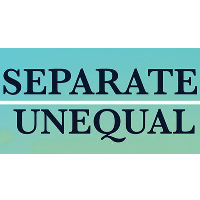California School Segregation Among Worst in the Nation

Sixty years after the U.S. Supreme Court ruled in the landmark Brown v. Board of Education that “separate but equal” school segregation was inherently unequal, a new study says California has grown more segregated and has the sharpest separation of students in the nation.
As the title Brown at 60: Great Progress, a Long Retreat and an Uncertain Future (pdf) suggests, the report from The Civil Rights Project at UCLA is not good news nationally. Blacks in the South, who were the focus of the court decision, made great strides in the early years after the decision, but have fallen back. It peaked in 1988 when 44% of black students attended majority-white schools, but thanks to efforts by the Reagan and Bush administrations in the '80s that number has dropped to 23% and is accelerating downward.
Latinos, who were not a huge demographic factor in 1954, are now. The typical Latino student is likely to be in a school with 58% Latinos. Black students are in schools with 48.8% African Americans and Asians check in at 24.5%. Whites are with whites 72.5% of the time.
The Latino numbers account in large part for California's abysmal integration numbers. While California is the third-worst state in the country in segregating African Americans, behind New York and Illinois, it earns the top spot among Latinos. In 1970, Latinos attended schools that were 54% white; that number is nearly 16% now.
California is last in the nation in “Latino Exposure to White Students” at 15.9%, followed by Texas (18%), New York (20.5%), New Mexico (21.2%) and Illinois (26%). It is third from the bottom for “Black Exposure to White Students” at 17.9%. New York is No. 1 at 3.7%, followed by Illinois 16.7%. Maryland is fourth (18.1%) and Texas is fifth (19.5%).
The study's authors assert that California “presently has no school integration policy.” The state was largely unaffected by the Brown decision, which was aimed primarily at 17 states with mandatory segregation of blacks, but took actions on its own. The California's Supreme Court said the state Constitution guaranteed a right to attend desegregated schools, and the Legislature directed school boards to enforce it.
But voters countermanded that with propositions. And in the 1990s, the U.S. Supreme Court handed down decisions that ended federal desegregation orders in San Francisco and San Jose, followed by other court rulings that further removed such orders in the state.
Along with higher levels of segregation, the report also found increased poverty among blacks and Latinos. On average, blacks attend schools where two-thirds of the students are from poor families. For Latinos, the number is 70%. In 1993, those numbers 52% and 58%, respectively. “The typical black student in California today attends a school with more than 2.5 times as many Latinos as blacks, thus making them a minority within a school dominated by another disadvantaged group,” the report said.
The most segregated schools (pdf) are in the Los Angeles Unified, Santa Ana Unified, San Bernardino Unified and Fontana Unified (near San Bernardino).
Going hand in hand with the segregation of minority and poor students is an educational experience far below that of their more integrated counterparts. They have lower graduation rates, fewer college preparatory courses, not as many experienced teachers and more disciplinary suspensions.
“The triple segregation, by ethnicity, poverty, and language that California Latino students face creates very severe obstacles to equal opportunity, and the situation has deteriorated for the past sixty years,” report co-author Jongyeon Ee wrote.
–Ken Broder
To Learn More:
Report: California Among Worst in The Nation in School Segregation (by Sharon Noguchi, San Jose Mercury News)
Despite Brown Ruling, Integrated Schools In California A Vanishing Dream (by Louis Freedberg, EdSource)
UCLA Report Finds Changing U.S. Demographics Transform School Segregation Landscape 60 Years After Brown v Board of Education (The Civil Rights Project at UCLA)
Brown at 60: Great Progress, a Long Retreat and an Uncertain Future (The Civil Rights Project at UCLA) (pdf)
- Top Stories
- Controversies
- Where is the Money Going?
- California and the Nation
- Appointments and Resignations
- Unusual News
- Latest News
- California Forbids U.S. Immigration Agents from Pretending to be Police
- California Lawmakers Urged to Strip “Self-Dealing” Tax Board of Its Duties
- Big Oil’s Grip on California
- Santa Cruz Police See Homeland Security Betrayal in Use of Gang Roundup as Cover for Immigration Raid
- Oil Companies Face Deadline to Stop Polluting California Groundwater





